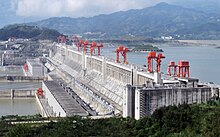Alternative energy sources
Renewable energy[edit]
Renewable energy flows involve natural phenomena such as sunlight, wind, tides, plant growth, and geothermal heat, as the International Energy Agency explains:[47]
Climate change concerns[48][49][50] and the need to reduce carbon emissions are driving increasing growth in the renewable energy industries.[51][52][53] Low-carbon renewable energy replaces conventional fossil fuels in three main areas: power generation, hot water/space heating, and transport fuels.[54] In 2011, the share of renewables in electricity generation worldwide grew for the fourth year in a row to 20.2%, with the global share of electricity from hydro power staying roughly constant at 16.3%.[55]
Renewable energy use has grown much faster than anyone anticipated.[56] The Intergovernmental Panel on Climate Change (IPCC) has said that there are few fundamental technological limits to integrating a portfolio of renewable energy technologies to meet most of total global energy demand.[57] At the national level, at least 30 nations around the world already have renewable energy contributing more than 20% of energy supply.
As of 2012, renewable energy accounts for almost half of new electricity capacity installed and costs are continuing to fall.[58] Public policy and political leadership helps to "level the playing field" and drive the wider acceptance of renewable energy technologies.[59] As of 2011, 118 countries have targets for their own renewable energy futures, and have enacted wide-ranging public policies to promote renewables.[60][61] Leading renewable energy companies include BrightSource Energy, First Solar, Gamesa, GE Energy,Goldwind, Sinovel, Suntech, Trina Solar, Vestas and Yingli.[62][63]
The incentive to use 100% renewable energy has been created by global warming and other ecological as well as economic concerns.[56] Mark Z. Jacobson says producing all new energy with wind power, solar power, and hydropower by 2030 is feasible and existing energy supply arrangements could be replaced by 2050. Barriers to implementing the renewable energy plan are seen to be "primarily social and political, not technological or economic". Jacobson says that energy costs with a wind, solar, water system should be similar to today's energy costs.[64] According to a 2011 projection by the (IEA)International Energy Agency, solar power generators may produce most of the world's electricity within 50 years, dramatically reducing harmful greenhouse gas emissions.[65] Critics of the "100% renewable energy" approach include Vaclav Smil and James E. Hansen. Smil and Hansen are concerned about the variable output of solar and wind power, NIMBYism, and a lack of infrastructure.[66]
Economic analysts expect market gains for renewable energy (and efficient energy use) following the 2011 Japanese nuclear accidents.[67][68] In his 2012 State of the Unionaddress, President Barack Obama restated his commitment to renewable energy and mentioned the long-standing Interior Department commitment to permit 10,000 MW of renewable energy projects on public land in 2012.[69] Globally, there are an estimated 3 million direct jobs in renewable energy industries, with about half of them in the biofuels industry.[70]
Some countries, with favorable geography, geology and weather well suited to an economical exploitation of renewable energy sources, already get most of their electricity from renewables, including from geothermal energy in Iceland (100 percent), and Hydroelectric power in Brazil (85 percent), Austria (62 percent), New Zealand (65 percent), and Sweden (54 percent).[71] Renewable power generators are spread across many countries, with wind power providing a significant share of electricity in some regional areas: for example, 14 percent in the U.S. state of Iowa, 40 percent in the northern German state of Schleswig-Holstein, and 20 percent in Denmark. Solar water heating makes an important and growing contribution in many countries, most notably in China, which now has 70 percent of the global total (180 GWth). Worldwide, total installed solar water heating systems meet a portion of the water heating needs of over 70 million households. The use of biomass for heating continues to grow as well. In Sweden, national use of biomass energy has surpassed that of oil. Direct geothermal heating is also growing rapidly.[71] Renewable biofuels for transportation, such as ethanol fuel and biodiesel, have contributed to a significant decline in oil consumption in the United States since 2006. The 93 billion liters of biofuels produced worldwide in 2009 displaced the equivalent of an estimated 68 billion liters of gasoline, equal to about 5 percent of world gasoline production.[71]












0 comments:
Post a Comment